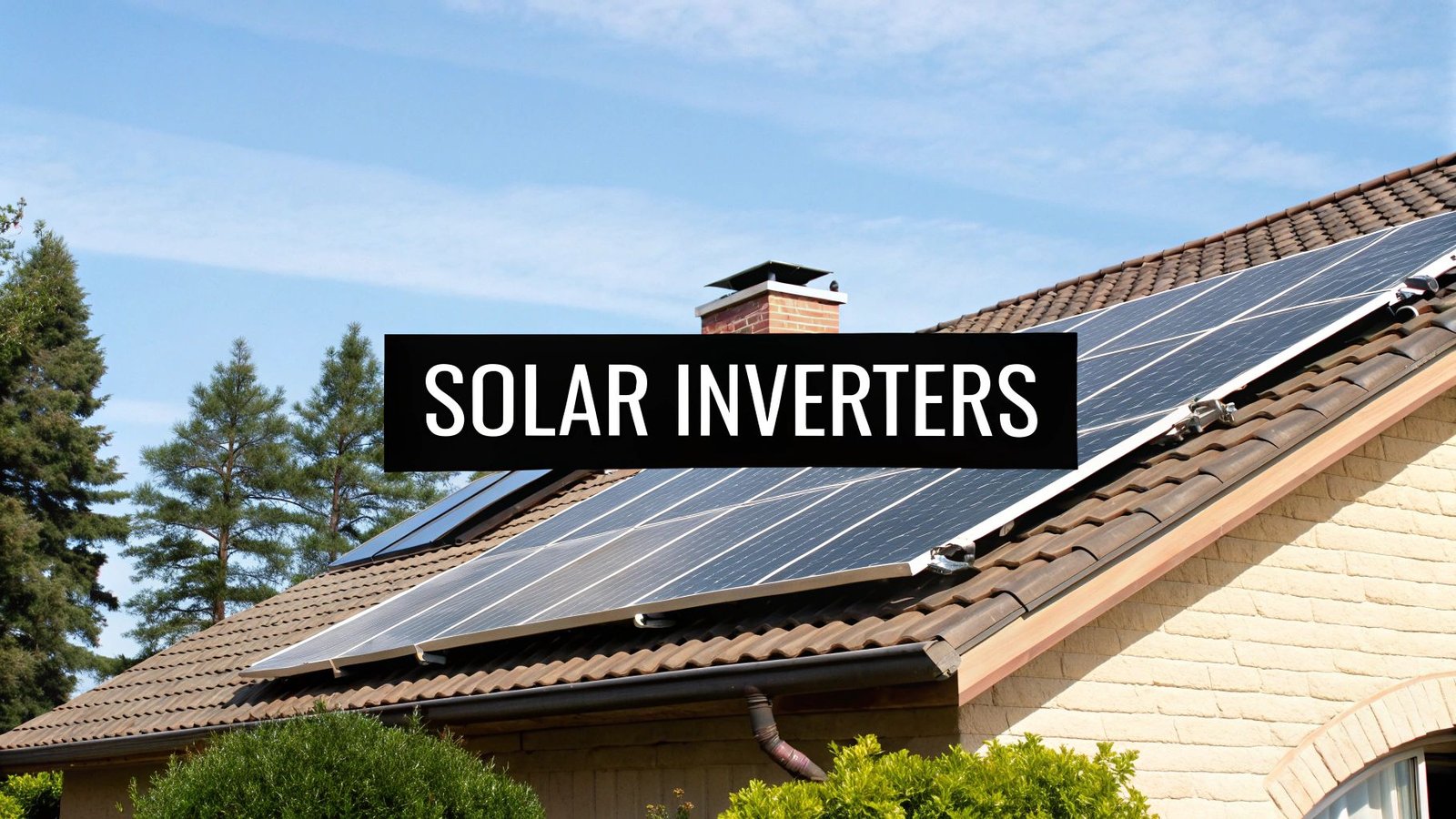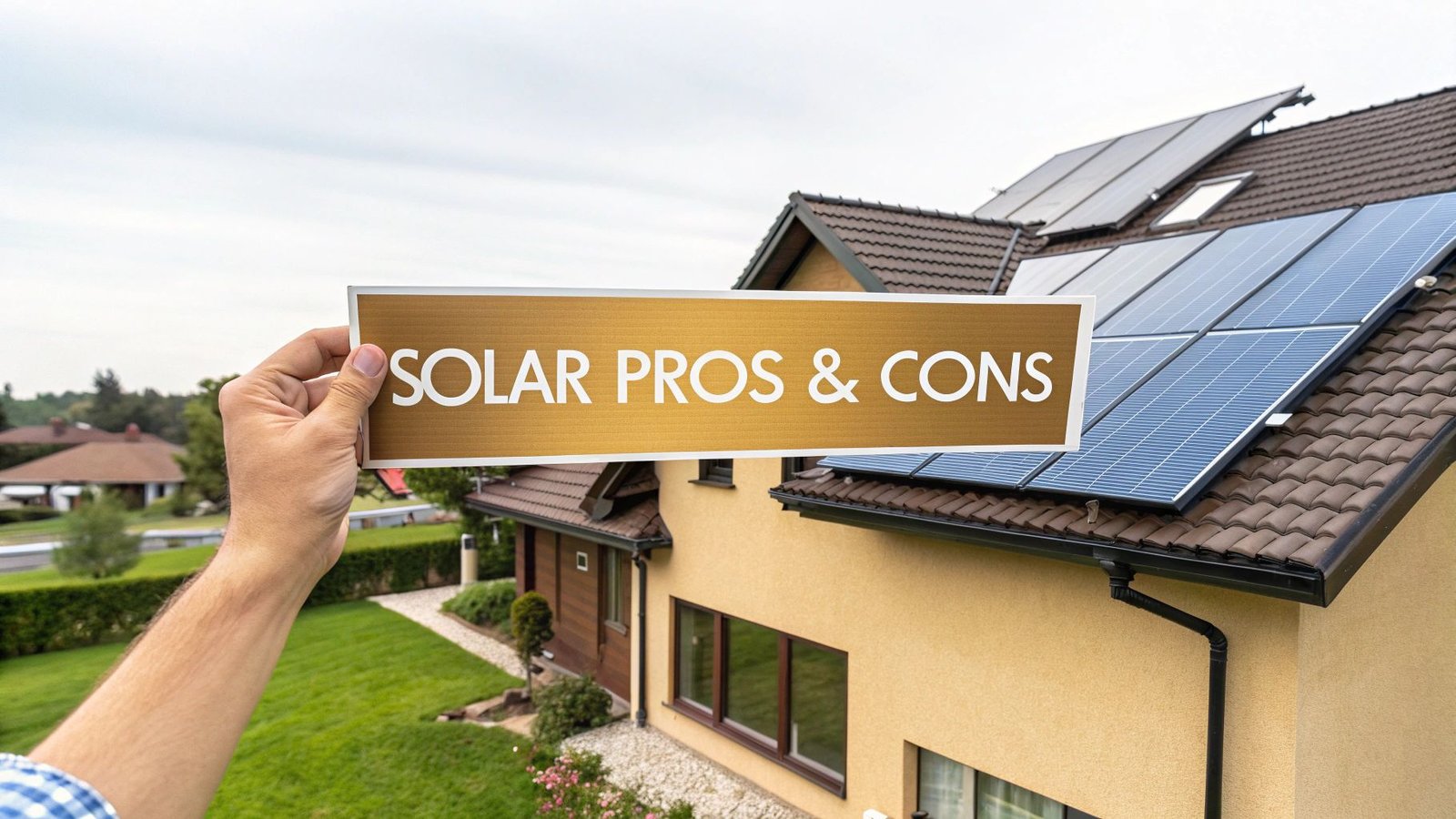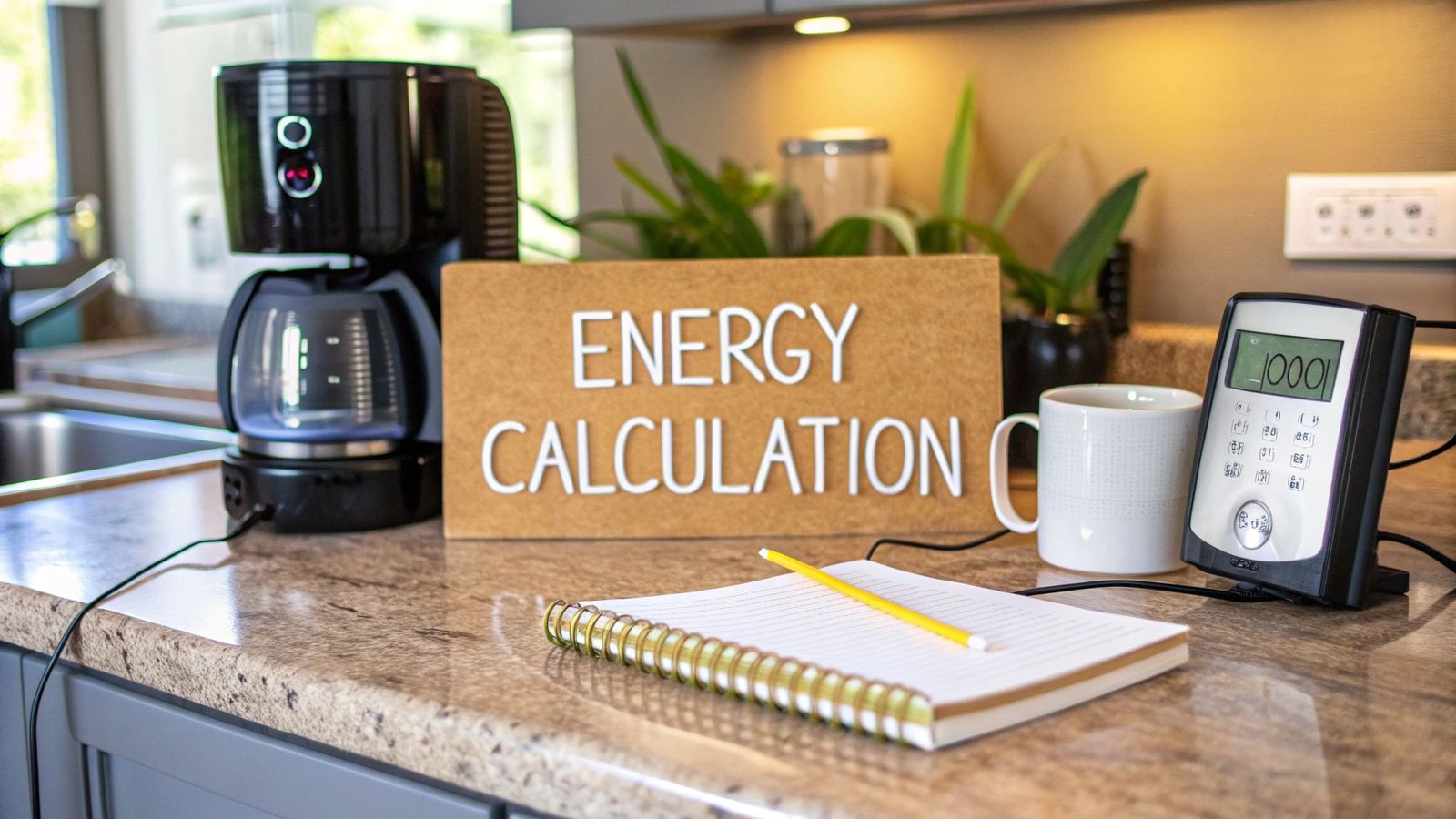Ever wonder how the sunlight hitting your roof actually powers your morning coffee? The magic happens inside a crucial but often overlooked device: the solar inverter. In simple terms, a solar inverter is what converts the Direct Current (DC) electricity your solar panels produce into the Alternating Current (AC) electricity that your home’s outlets and appliances need to run.
The Brains Behind Your Home Solar System
Think of the solar inverter as the brain of your entire solar power setup. Your panels are the muscle, soaking up raw solar energy, but it's the inverter that cleverly translates that energy into a language your home can understand. Without this vital conversion step, all the power your panels collect would be useless for your standard household electronics.
This single piece of equipment is what makes tapping into clean, renewable energy a practical reality for homeowners. It’s the essential bridge between the sun's rays and your daily life, making sure everything from your lights to your laptop gets the power it needs.
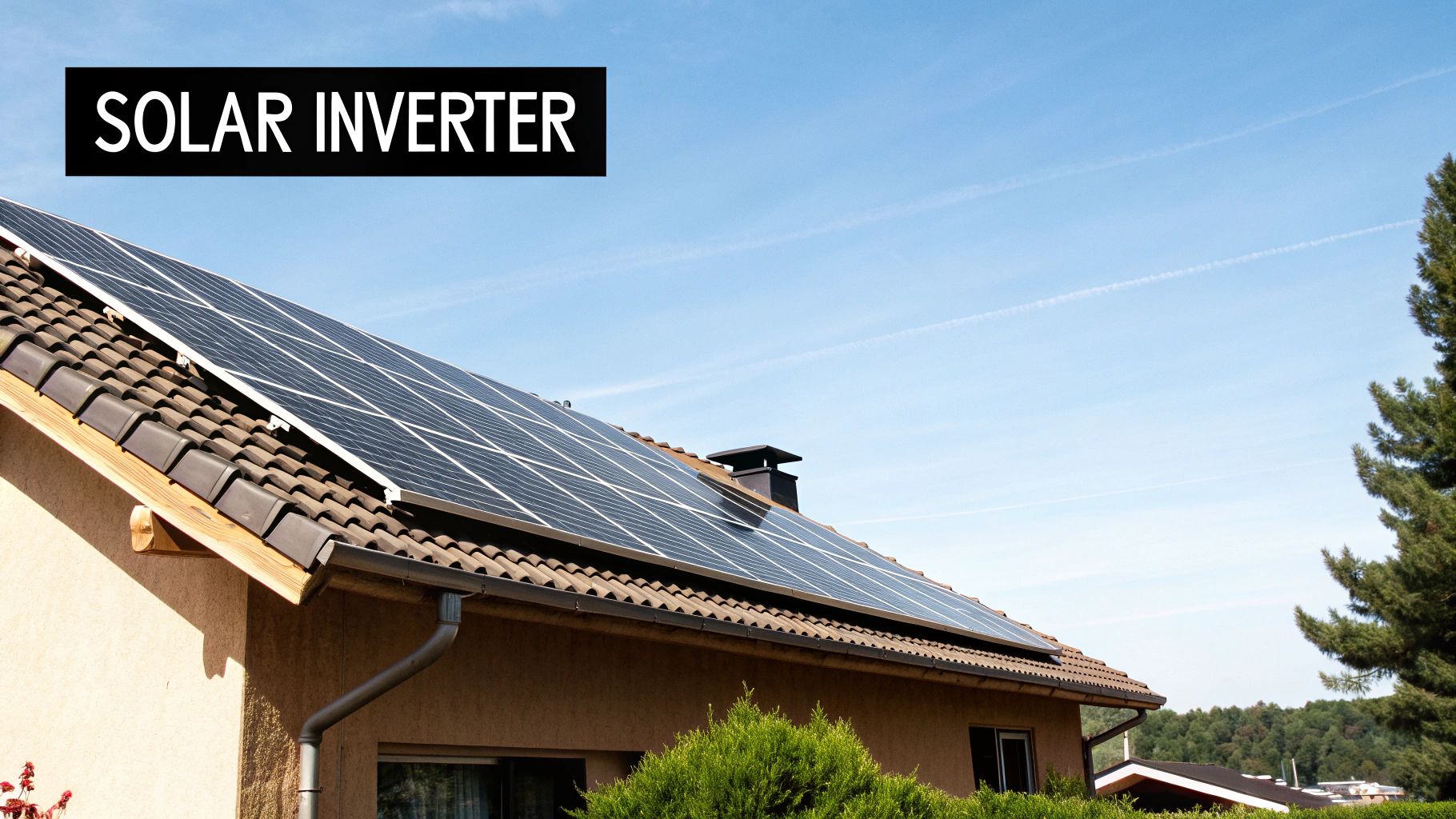
From Sunshine To Your Socket
So, how does this energy journey from the sun to your wall socket actually work? It's a fascinating process orchestrated entirely by the inverter. The device doesn’t just flip a switch from DC to AC; it also carefully syncs the frequency and voltage of the electricity to match the power grid, ensuring a smooth, stable, and safe supply of power throughout your home.
A solar inverter isn't just an add-on; it's the core component that makes a solar energy system work. It closes the gap between raw solar power generation and usable electricity for your home.
How Inverters Turn Sunshine Into Usable Power
So, how does an inverter actually perform this electrical alchemy? To really get it, let's start with a simple analogy. Think of the Direct Current (DC) power coming from your solar panels like a steady, one-way stream. It flows in a single, unwavering direction—great for things like charging a battery, but totally incompatible with the appliances in your home.
Your home's outlets, on the other hand, run on Alternating Current (AC). Picture this as a busy two-way street, where the flow of traffic has to constantly and smoothly reverse direction. The inverter’s job is to act as the master traffic controller, converting that one-way stream into a bustling, two-way flow of electricity.
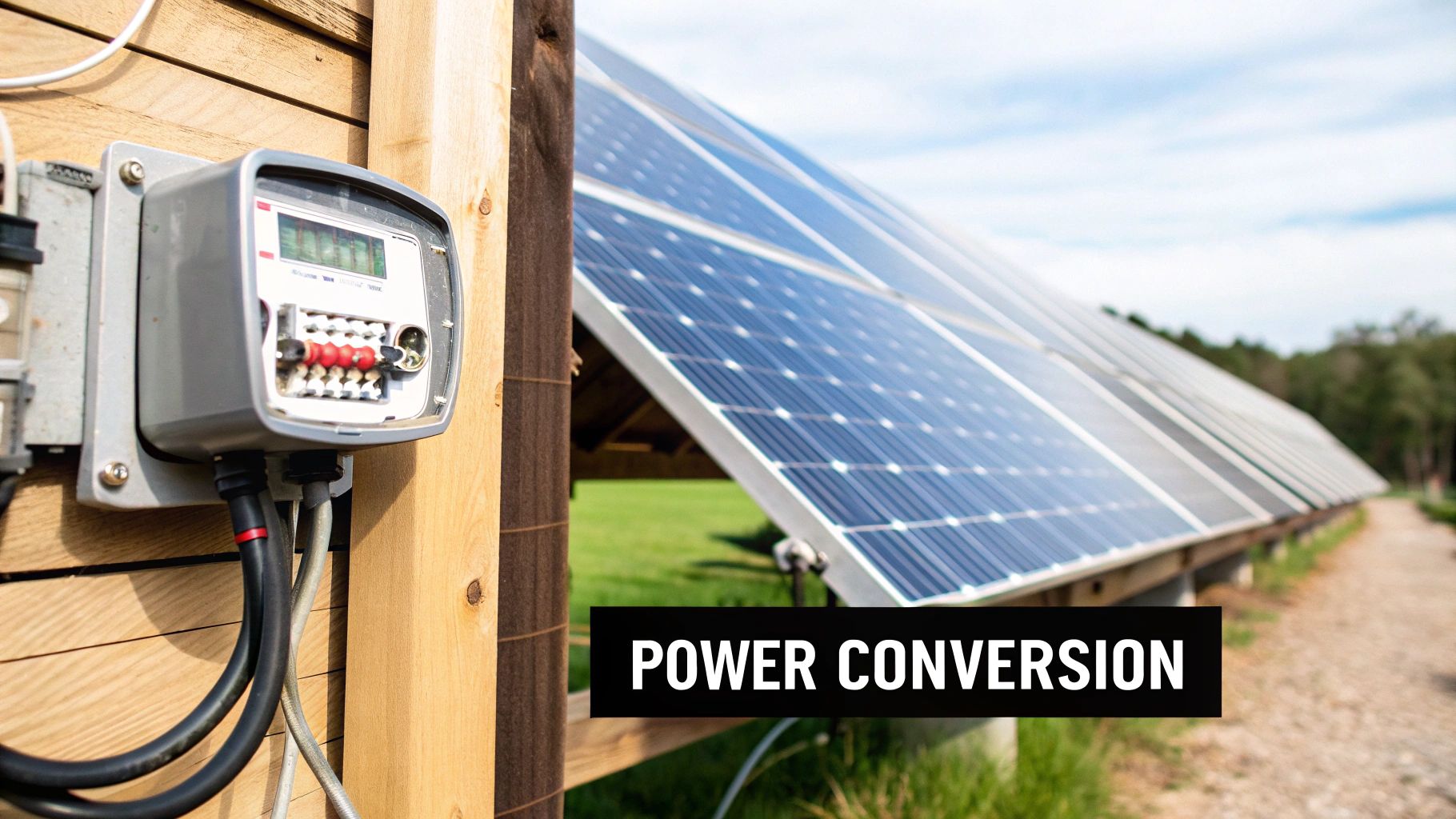
The Core Conversion Process
When the inverter receives the raw DC electricity from the panels, it gets to work. Inside the inverter are sophisticated electronic switches called transistors that start flipping the current's direction back and forth, over and over, dozens of times every second. This lightning-fast switching is what transforms the flat, one-directional DC signal into the oscillating waveform of AC power.
But it’s not just about flipping a switch. A good inverter has to manage this conversion with incredible precision to produce a clean, stable electrical current. The ideal output is what we call a "pure sine wave."
A pure sine wave is the gold standard for AC power. It’s a smooth, predictable, and consistent electrical current that’s identical to—and often even cleaner than—the power delivered by the utility grid.
This quality is non-negotiable for protecting the sensitive electronics found all over a modern home. A lower-quality output, often called a "modified sine wave," can be choppy and inconsistent, causing problems or even damage to devices like:
-
Laptops and computers
-
Smart TVs and high-fidelity audio equipment
-
Appliances with variable-speed motors (like new refrigerators or air conditioners)
-
Critical medical equipment
Why A Clean Sine Wave Matters
The smooth, reliable rhythm of a pure sine wave ensures that the power coursing through your home's wiring is just as safe and dependable as what you'd get from your local utility company. When an inverter produces a clean sine wave, your appliances run efficiently, quietly, and without the risk of humming noises or long-term wear and tear.
In the end, the inverter doesn’t just convert power; it refines it. It takes the raw, direct energy captured from the sun and meticulously shapes it into the high-quality, stable electricity needed to safely power your daily life. This careful process is what makes the solar inverter one of the most critical components of your entire system, directly influencing both its performance and the longevity of everything you plug into the wall.
Choosing Your Inverter: String or Micro?
When you’re going solar, picking your inverter is one of the most critical decisions you'll make. It’s not a one-size-fits-all situation. Just like you wouldn't buy a sports car for hauling lumber, the right inverter depends entirely on your home, your roof, and what you want to achieve with your energy.
The solar world essentially offers two main players for homeowners: the classic string inverter and the high-tech microinverter. Each has its own set of strengths and is designed for a different job. Let's dig into what makes each one tick so you can figure out which is the perfect fit for you.
The Workhorse: String Inverters
Think of the inversor monofásico as the tried-and-true workhorse of the solar industry. For years, this has been the standard approach. It works by linking a group of solar panels together in a series (a "string") that feeds into one central inverter box. This box, usually tucked away in a garage or on the side of the house, does the heavy lifting of converting all the DC power from that string into usable AC power for your home.
This setup is incredibly efficient and budget-friendly for homes with simple, wide-open roofs where every panel faces the same direction and gets full sun all day. But there’s a catch, and it’s a big one. It operates on an "all for one, one for all" basis.
A string inverter system performs only as well as its weakest link. If just one panel is shaded or underperforming due to debris, the output of every other panel in that string is reduced to match it.
It's a bit like an old string of holiday lights—if one bulb burns out, the whole section goes dark. This makes string inverters a poor choice for roofs that have to contend with shade from trees, chimneys, or multiple angles.
The Precision Performers: Microinverters
This is where microinverters come in. They take a completely different, high-precision approach. Instead of one big inverter, a small microinverter is attached to the back of every single panel. Each one converts DC to AC right there on the roof, meaning every panel is its own independent power producer.
This is a game-changer for complicated roofs. Got multiple sections facing different directions? A pesky tree that casts a shadow in the afternoon? No problem. If one panel’s output dips, the rest keep chugging along at full power, completely unaffected. As a bonus, this technology lets you monitor the performance of each individual panel, which is great for troubleshooting.
Microinverters generally squeeze more energy out of your system, but they do come with a higher price tag and a more involved installation process compared to their string inverter cousins.
String vs Micro Inverters At a Glance
Here’s a quick comparison to help you see the key differences at a glance. This table breaks down the main features, pros, and cons to help guide your decision.
|
Característica |
Inversor de cadenas |
Microinverter |
|---|---|---|
|
System Design |
One central inverter for a “string” of panels. |
One small inverter per individual panel. |
|
Lo mejor para |
Simple, unshaded roofs with panels facing one direction. |
Complex or partially shaded roofs; detailed monitoring. |
|
Rendimiento de la sombra |
Poor. Shade on one panel reduces the output of the entire string. |
Excellent. Unaffected panels continue at max production. |
|
Coste |
$ (Most affordable) |
$$$ (Highest upfront cost) |
|
Supervisión |
System-level only. |
Panel-level monitoring. |
|
Battery Ready? |
No, requires extra equipment (AC-coupled). |
Yes, but requires extra equipment (AC-coupled). |
|
Reliability |
Single point of failure. If inverter fails, system is down. |
No single point of failure. One failure doesn’t stop the system. |
Ultimately, the best inverter is the one that aligns with your property's characteristics, your budget, and your long-term energy goals. A simple, sunny roof might be perfect for a cost-effective string inverter, while a more complex roof will get far more value from microinverters. And if energy independence i
The Rise of Smart Inverters and Energy Management
Not too long ago, a solar inverter had a straightforward job: turn the DC electricity from your panels into the AC power your home uses. That was it. But today's inverters are a whole different beast. They've evolved far beyond simple power conversion and are now stepping up as intelligent energy managers for your entire home.
This shift is all thanks to the rise of the smart inverter. Think of it less as a simple converter and more as the command center for your home's energy ecosystem. These advanced devices don't just report what your system is doing—they actively manage and optimize it.
Two-Way Communication and Grid Support
The real game-changer with a smart inverter is its ability to have a two-way conversation with the utility grid. Older inverters were one-way streets, just pushing power out. A smart inverter, however, can receive signals and commands from the utility.
This capability is huge. It means your inverter can dynamically adjust its output to help keep the grid stable, which is becoming critical as more renewables like solar and wind connect to it.
A smart inverter acts as a helpful partner to the utility grid. Instead of being a passive contributor, it can actively respond to the grid's needs, such as adjusting voltage or frequency to prevent disturbances, making the entire energy network more stable and resilient.
Suddenly, your home solar setup isn't just an isolated power generator. It becomes a cooperative player in a larger, more intelligent energy network.
The Central Hub for Your Energy Future
Beyond its role with the grid, a smart inverter's true power shines in its ability to orchestrate all the energy moving through your home. It’s the brain that connects your solar panels, a home battery, and even your appliances, making sure they all work together seamlessly.
This opens up a whole new world of control and efficiency, with features that were once science fiction:
-
Remote Diagnostics: Installers can often diagnose and even fix issues from their office, saving you the time and hassle of a service call.
-
Automatic Optimization: The inverter is always watching, making tiny, real-time adjustments to squeeze every possible watt out of your panels.
-
Seamless Battery Integration: Smart inverters are designed from the ground up to manage a home battery. They intelligently decide when to store surplus solar power, when to use that stored energy for your home, and when to sell it back to the grid.
Ultimately, a smart inverter is no longer just a component; it's the foundation for a modern, reliable, and truly independent home energy system.
Don't Overlook Warranty and Reputation
Your inverter is a workhorse, operating day in and day out for years. Because of this constant use, durability is absolutely crucial. A solid warranty is the clearest signal of a manufacturer's confidence in its own product.
-
Inversores de cadenas: These usually come with a 10-12 year warranty.
-
Microinverters & Power Optimizers: You'll often see 20-25 year warranties, which are designed to line up with the lifespan of the solar panels themselves.
But a warranty is only part of the story. You also need to look at the manufacturer's track record. Stick with established brands known for their reliability and responsive customer support. After all, a 25-year warranty doesn't mean much if the company is out of business or impossible to get ahold of when you need a repair.
Your Roof's Impact on Inverter Choice
Finally, the physical characteristics of your roof play a huge role in this decision. If you're lucky enough to have a simple, south-facing roof with zero shading issues, a top-tier string inverter is an excellent and highly cost-effective option.
However, if your roof is more complex—with multiple angles, dormers, or partial shade from a pesky tree or chimney—the best choice becomes much clearer. For these situations, a system built with microinverters or power optimizers is practically a necessity. This technology allows each panel to operate independently, so if shade hits one panel, it won’t tank the performance of the entire system. This ensures you wring every possible watt of power from your array, no matter how complicated your roof is.
Respuestas a sus principales preguntas sobre inversores de conexión a red
Es completamente normal que le surjan algunas preguntas mientras recompone el puzzle de la energía solar. Al fin y al cabo, es una gran decisión para su hogar. Para ayudar a aclarar las cosas, he reunido algunas de las preguntas más comunes que los propietarios hacen antes de hacer el cambio.
¿Cuánto suelen durar los inversores de conexión a red?
La vida útil de un inversor depende del modelo que elijas y de las condiciones en las que viva. Un inversor inversor monofásico generalmente tiene una garantía de De 10 a 15 años. Como sus paneles solares están hechos para durar De 25 a 30 añosPor lo tanto, es probable que tenga que prever al menos una sustitución del inversor a lo largo de la vida útil de su sistema.
Microinversorespor otro lado, están fabricados para durar. A menudo vienen con garantías que duran De 20 a 25 añoslo que concuerda perfectamente con la vida útil de los paneles. Sin embargo, tenga en cuenta que el calor extremo o las inclemencias meteorológicas pueden afectar a cualquier dispositivo electrónico, incluidos los inversores.
¿Qué ocurre si falla mi inversor de conexión a red?
Si su inversor deja de funcionar, sus paneles solares dejarán de enviar energía a su hogar. Ésa es la mala noticia. La buena noticia es que no se quedará a oscuras. Tu casa empezará a recibir automáticamente toda la electricidad de la red pública, igual que antes de tener energía solar.
Sabrá casi de inmediato si algo va mal. Los inversores actuales incorporan sistemas de supervisión inteligentes que detectan cualquier problema o avería y envían una alerta directamente a su teléfono y al instalador.
Un inversor averiado casi siempre está cubierto por la garantía. Tu empresa de instalación solar se encargará de la reclamación y la sustitución, para que tu sistema vuelva a funcionar y puedas empezar a generar tu propia energía limpia sin apenas complicaciones.
¿Listo para explorar la solución solar e inversor perfecta para su hogar? Los expertos de Energía radiante puede diseñar un sistema de alto rendimiento que satisfaga sus necesidades y objetivos energéticos particulares. Más información obtener un presupuesto personalizado.

